Report of Findings
Att_14g_Report of Findings_revised 210323.docx
National Health and Nutrition Examination Survey
Report of Findings
OMB: 0920-0950
Attachment 14g: Report of Findings
Early Reporting Letters
General
Laboratory
<On official letterhead>
Participant Name and Address
<Insert Date>
Dear <Insert Participant name>,
Recently, you took part in the National Health and Nutrition Examination Survey (NHANES). The survey is run by the National Center for Health Statistics, part of the Centers for Disease Control and Prevention. We reviewed your test results from your exam on <insert date>. We found that some values were abnormal and need your immediate attention.
We cannot be sure whether or not these test results represent illness. Only your doctor can determine that. We strongly recommend that you talk to your doctor and give him or her your test results on the enclosed sheet. He or she can evaluate your findings and help you understand what they mean for your health. The NHANES program will not pay for any follow-up tests or care you may require. You are responsible for securing your test results. If you do not want anyone else to review your results place them in a secure place so no one else can review them.
The exam was not intended to be a complete physical exam. It is not a substitute for a visit to a doctor. Our survey clinicians are not authorized to administer treatment or engage in any follow-up with survey participants.
You will receive a full report of your exam findings in the future, but we thought you should know about these results right away.
If you have any questions, you can reach me on one of our toll-free numbers below between 7:30 AM and 4:30 PM Eastern Time, Monday through Friday.
English: 1-800-452-6115, press “2”
Spanish: 1-800-452-6115, press “3”
Sincerely,
![]()
Duong T. Nguyen
Chief Medical Officer
Enclosure
<insert participant ID>
Early Reporting Letter – Hemoglobin Variants
<On official letterhead>
Participant Name and Address
<Insert Date>
Dear <Insert Participant name>,
Dear <insert SP name or Parent/guardian of SP>,
Recently, <you/ your child> took part in the National Health and Nutrition Examination Survey. The survey is run by the National Center for Health Statistics, part of the Centers for Disease Control and Prevention. We reviewed <your/your child’s> test results from the exam on <insert date>. We found that some results were abnormal and require your immediate attention.
As part of this exam, <your/your child’s> blood was tested for certain Hemoglobin variants. Hemoglobin variants are caused by genetic abnormalities that affect red blood cells. Your child’s blood sample taken on <insert exam date> was found to have <% ____ Hemoglobin <S, C, D, E, or F>>. Knowing these results may affect clinical care and family planning in the future. We highly recommend that you follow up with <your/your child’s> doctor if you are not aware of this condition.
Hemoglobin variants are usually found in people whose families originally came from areas in Africa, the Middle East, or Asia. In the United States, these conditions are usually discovered after birth. Most newborns are tested as part of recommended newborn screening programs. Persons born outside of the United States, who have not had their blood screened, may not be aware of the condition.
Persons with hemoglobin variants may experience mild or severe symptoms. How severe the symptoms are depends on the variant type and on how much is present in the blood. We have provided you with the percent in the result above so that you will have this information when you follow up with <your/your child’s> doctor.
The NHANES program will not pay for any follow-up tests or care you may need, but we will be available to talk with you or your doctor about this letter and to answer any questions you may have. You are responsible for securing your test results. If you do not want anyone else to review your results place them in a secure place so no one else can review them. You can reach me on our toll-free number 1-800-452-6115 between 7:30 AM and 4:30 PM Eastern Time, Monday through Friday.
Sincerely,
Duong T Nguyen, DO
Chief Medical Officer
<insert participant ID>
Early Reporting Letter – Hepatitis C
<On official letterhead>
Participant Name and Address
<Insert Date>
Dear <Insert Participant name>,
Recently, you took part in a voluntary health examination at special mobile facilities operated by the Centers for Disease Control and Prevention. As part of this exam your blood was tested for hepatitis C virus. Your blood sample collected on <insert exam date>, shows you are currently infected with the hepatitis C virus even though you may never have felt sick.
If no one has told you before that you have the virus, we strongly recommend you take this letter to your doctor as soon as you can. You will want to talk with your doctor about possible treatment for hepatitis C and how to prevent spreading the disease to other people. Your doctor may want to do more tests to find out if the virus has done any damage to your liver.
Your doctor should know that our laboratory is determining the genotype of the hepatitis virus; however, the result will not be available for several months. He/She can call us at the phone number provided below to get the result. The genotype may be useful in the treatment decisions your doctor will make.
Almost four million Americans are infected with hepatitis C virus. Most persons who are infected carry the virus for the rest of their lives. The infection can lead to liver damage, although many people with the virus never feel sick. We have enclosed a fact sheet with information on hepatitis C. You may obtain other information on hepatitis C by calling toll free:
American Liver Foundation: http://www.liverfoundation.org or 1-800-465-4837
Centers for Disease Control and Prevention: http://www.cdc.gov/hepatitis
You are responsible for securing your test results. If you do not want anyone else to review your results place them in a secure place so no one else can review them. If you have any questions, you can reach me on one of our toll-free numbers below between 7:30 AM and 4:30 PM Eastern Time, Monday through Friday.
English: 1-800-452-6115, press “2”
Spanish: 1-800-452-6115, press “3”
Sincerely,
![]()
Duong T. Nguyen
Chief Medical Officer
Enclosure
<insert participant ID>
All Hepatitis C Early Reports are accompanied by the below flyer. This flyer is available in English or Spanish from Hepatitis C General Information (cdc.gov) and was most recently updated in 2020.

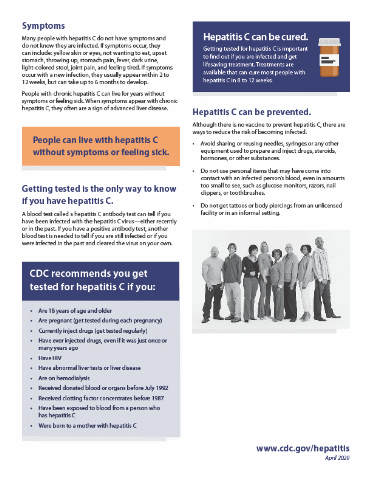
Early Reporting Letter – Hepatitis B
<On official letterhead>
Participant Name and Address
<Insert Date>
Dear <Insert Participant name>,
Recently, you took part in the National Health and Nutrition Examination Survey (NHANES). The survey is run by the National Center for Health Statistics, part of the Centers for Disease Control and Prevention. As part of this exam your blood was tested for hepatitis B virus. Your blood sample taken on <insert date>, shows you were infected with the hepatitis B virus, even though you may never have felt sick. Having received the vaccine for hepatitis B would NOT cause this test to be positive (your blood was positive for the hepatitis B surface antigen). You may or may not still have the virus in your blood.
If no one has told you before that you had the virus, we strongly recommend you take this letter to your doctor as soon as you can. You will want to talk with your doctor about possible treatment for hepatitis B and how to prevent spreading the disease to other people. Your doctor may want to do more tests to find out if the virus has done any damage to your liver. We have enclosed a fact sheet with information on hepatitis B. You may obtain other information on hepatitis B by calling toll free:
American Liver Foundation 1-800-223-0179 Hepatitis Foundation International 1-800-891-0707
or the CDC web site http://www.cdc.gov/hepatitis
We want to give you this important information and urge you to see your doctor. The NHANES program will not pay for any follow-up tests or care you may need, but we will be available to talk with you or your doctor about this letter and to answer any questions you may have. You are responsible for securing your test results. If you do not want anyone else to review your results place them in a secure place so no one else can review them.
You can reach me on one of our toll-free numbers below between 7:30 AM and 4:30 PM Eastern Time, Monday through Friday.
![]()
English: |
1-800-452-6115, press "1" |
Spanish: |
1-800-452-6115, press "2" |
Sincerely, |
|
Duong T. Nguyen, D.O.
Chief Medical Officer
Enclosure
<insert participant ID>
Laboratory Information for Hepatitis B Testing in NHANES
The following CLIA-certified laboratory performed your hepatitis B test:
Centers for Disease Control and Prevention
National Center for HIV, Hepatitis, STD and TB Prevention Division of Viral Hepatitis
Laboratory Branch 1600 Clifton Road NE
Building 18, 3-218, MS A33
Atlanta, GA 30329
All Hepatitis B Early Reports are accompanied by the below flyer. This flyer is available in English or Spanish from Hepatitis B - Basic Information (cdc.gov) and was most recently updated in 2016.
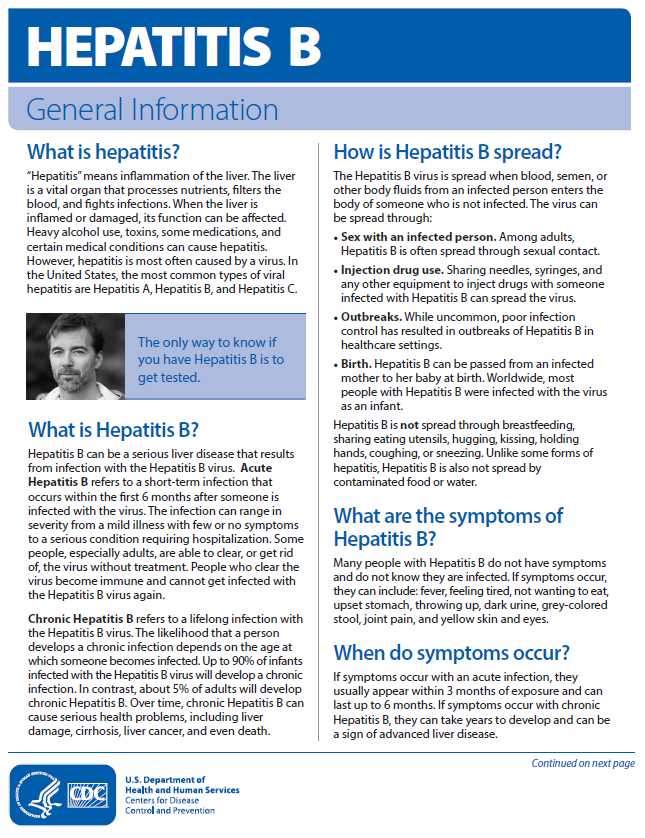
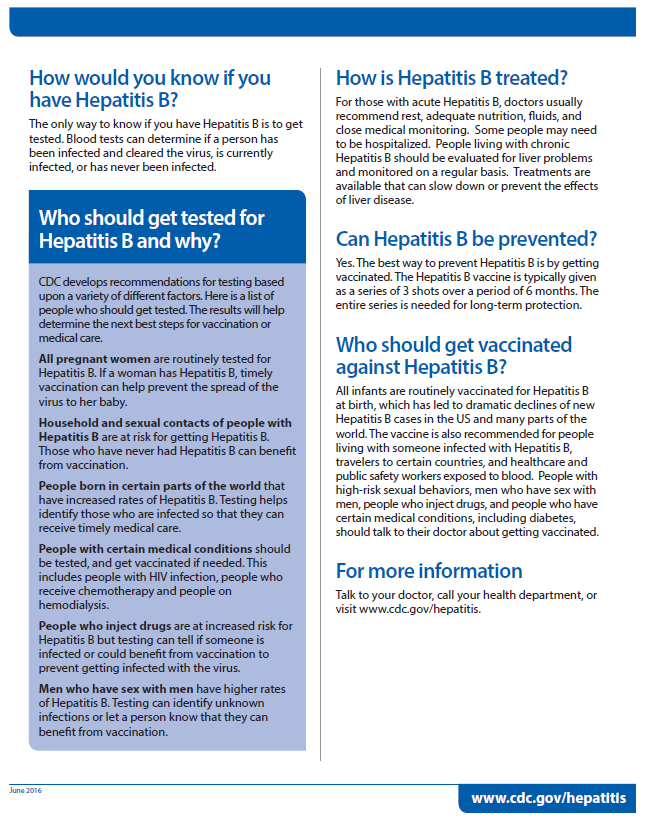
Early Reporting Letter – Hepatitis D
<On official letterhead>
Sample person name
Address
Dear <insert name>,
Recently, <you/ your child> took part in the National Health and Nutrition Examination Survey. The survey is run by the National Center for Health Statistics, part of the Centers for Disease Control and Prevention. As part of this exam, <you/ your child> blood was tested for hepatitis D virus and hepatitis B virus. Your blood sample taken on <insert exam date>, shows <you/ your child> <are/is> infected with the hepatitis D virus along with the hepatitis B virus. <You/ Your child> may not have felt sick.
Hepatitis D only happens in people who also have the hepatitis B virus. You can have Hepatitis D for a short time, or it can become a long-term, chronic infection. Hepatitis D can cause serious illness in some people that can lead to life-long liver damage.
We strongly recommend you see <your/ your child’s> doctor soon to discuss treatment and how to prevent spreading the disease to other people. The NHANES program will not pay for any follow-up tests or care you may require, but we will be available to talk with you or your doctor about this letter and to answer any questions you may have. You are responsible for securing your test results. If you do not want anyone else to review your results place them in a secure place so no one else can review them.
You can reach me on our toll-free number 1-800-452-6115 between 7:30 AM and 4:30 PM Eastern Time, Monday through Friday.
Sincerely yours,
![]()
Duong T Nguyen, DO
Chief Medical Officer
<insert participant ID>
Early Reporting Letter – Butyrylcholinesterase
<On official letterhead>
Sample person name
Address
Date
Dear <insert SP name or Parent/guardian of SP>,
Recently, <you/ your child> took part in the National Health and Nutrition Examination Survey. The survey is run by the National Center for Health Statistics, part of the Centers for Disease Control and Prevention. We reviewed <your/your child’s> test results from the exam on <insert date>. We found that some results need your attention.
As part of your exam, <your/your child’s> blood was tested for butyrylcholinesterase.
<Your/your child’s> butyrylcholinesterase level was low at less than 0.05 U/ml.
This is a new test developed to understand what butyrylcholinesterase levels are like in the general population. Although this test is not the same test used in clinics or hospitals, we think it is important for you to know your result as it may be important to your health.
Low butyrylcholinesterase is also known as Pseudocholinesterase deficiency. Having a low level happens in a very small percent of people. Some people who have a low level may react to certain medicines used in general anesthesia for surgery. Although this reaction is rare, it is important to tell your doctor so that a safe medication is used for you.
The NHANES program will not pay for any follow-up tests or care you may require. We will be available to talk with you or your doctor about this letter and to answer any questions you may have. You are responsible for securing your test results. If you do not want anyone else to review your results place them in a secure place so no one else can review them.
You can reach me at 1-800-452-6115. I am available Monday through Friday from 7:30 AM to 4:30 PM Eastern Time.
![]() Sincerely,
Sincerely,
Duong T Nguyen, DO
Chief Medical Officer
<insert participant ID>
Early Reporting Letter – High Urine Arsenic
<On official letterhead>
Participant Name and Address
<Insert Date>
Dear <Insert Participant name>,
Recently, you took part in the National Health and Nutrition Examination Survey (NHANES). The survey is run by the National Center for Health Statistics, part of the Centers for Disease Control and Prevention. As part of this exam, your urine was tested for arsenic, a metal widespread in the environment. The arsenic level in your urine sample taken on <insert date> was above the usual range (reference range). This suggests you were exposed to arsenic during the week before your exam.
We strongly recommend you take this letter to your doctor as soon as you can. You will want to talk with your doctor about any other tests and possible treatment that you may need.
We want to give you this important information and urge you to see your doctor. The NHANES program will not pay for any follow-up tests or care you may require, but we will be available to talk with you or your doctor about this letter and to answer any questions you may have. You are responsible for securing your test results. If you do not want anyone else to review your results place them in a secure place so no one else can review them.
You can reach me on one of our toll-free numbers below between 7:30 AM and 4:30 PM Eastern Time, Monday through Friday.
English: 1-800-452-6115, press “2”
Spanish: 1-800-452-6115, press “3”
Sincerely,
![]()
Duong T. Nguyen
Chief Medical Officer
Enclosure
Early Reporting Letter - High Urine Arsenic (page 2)
<On official letterhead>
<Insert Participant Name and address>
Recently, the person named in this report participated in the National Health and Nutrition Examination Survey (NHANES), conducted by the National Center for Health Statistics, part of the Centers for Disease Control and Prevention.. The objective of the survey is to obtain information on the health and nutrition status of the U.S. population. The survey was performed on a random sample of individuals living in your region.
The listed laboratory value from the individual named above was sufficiently increased to require early reporting.
Test |
Participant's value |
Reference range |
Total urinary arsenic |
ug/L |
See below |
Total urinary arsenic values greater than 50 ug/L are suggestive of increased exposure to arsenic during the week before the urine collection date. The incidence of health effects is indeterminate in the range of 50-200 ug/L. In persons having urinary arsenic concentrations greater than 200 ug/L on a long-term basis, the incidence of health effects is low, but increases with the length of time over which exposure has occurred and the concentration level. The chronic effects of arsenic include: skin pigmentation changes, plantar and palmar hyperkeratotic papules, peripheral vascular insufficiency, and an increased incidence of cancer (skin, bladder, lung).
Urinary arsenic concentration levels will represent a person’s most recent exposures (within days or weeks). The levels do not indicate length of exposure. Concentration may increase or decrease at different times depending on changes in: exposure (intake), personal activities, diet, timing of specimen collection and the influence of health conditions. Persons having the same intake may have differences in levels due the influence of these factors as well as genetic differences between individuals.
Reference comparison values for normal populations will vary with population and the conditions under which the study was performed. Reference comparison values may vary with age, gender, race, location, activities, analytic methods and other factors.
Urine arsenic levels in healthy adults between 5 to 50 µg/L generally correspond to whole blood arsenic levels between 2-23 µg/L. Ref: Tietz, R.E. Ed.: Clinical Guide to Laboratory Tests. 3rd ed. Philadelphia, W.B. Saunders Col, 1995.
The examination was not intended to be a complete physical examination nor a substitute for a visit to a doctor. Our survey physicians are not authorized to administer treatment or engage in any follow-up with the survey participants.
You are responsible for securing your test results. If you do not want anyone else to review your results place them in a secure place so no one else can review them. If you have any questions, you can reach me on one of our toll-free numbers below between 7:30 AM and 4:30 PM Eastern Time, Monday through Friday.
English: 1-800-452-6115, press “2”
Spanish: 1-800-452-6115, press “3”
Sincerely,
![]()
Duong T. Nguyen
Chief Medical Officer
Early Reporting Letter – Cytomegalovirus
<official letterhead>
Date
Dear Parent/guardian,
Recently, your child took part in the National Health and Nutrition Examination Survey. The survey is run by the National Center for Health Statistics, part of the Centers for Disease Control and Prevention. We reviewed your child’s test results from his/her exam on <insert date>. We found that some values were abnormal and need your immediate attention.
As part of this exam your child’s blood was tested for cytomegalovirus (CMV) infection. Your child’s blood sample taken on <insert exam date>, was positive for CMV infection.1
CMV is a very common virus that most people get. Once a person gets CMV it stays in his/her body for life. Nearly all healthy children who get CMV have no symptoms and parents will likely not even know that their child has been infected. If your child has serious medical problems, including a weakened immune system, CMV can cause more serious problems. We recommend you take this letter to your doctor.
Although CMV infection will not likely harm your child, children with a CMV infection can pass the virus to pregnant women. If a woman gets a new CMV infection while pregnant, her baby can be harmed. If your child has CMV and you are pregnant or planning to get pregnant, we recommend you learn about CMV. There are simple steps you can take to lower your risk of CMV infection at this website http://www.cdc.gov/cmv/index.html. You may also call the number below for this information.
The NHANES program will not pay for any follow-up tests or care you may need, but we will be available to talk with you or your doctor about this letter and to answer any questions you may have. You can reach me on our toll-free number 1-800-452-6115 between 7:30 AM and 4:30 PM Eastern Time, Monday through Friday.
Sincerely,
![]()
Duong T Nguyen, DO
Chief Medical Officer
Enclosure
<insert participant ID>
Cytomegalovirus Fact Sheet
Am Fam Physician. 2003 Feb 1;67(3):526.
What is cytomegalovirus?
Cytomegalovirus (say: “si-toe-meg-ah-low-vi-russ”) or CMV is a virus that infects cells and causes them to become enlarged. Many people are infected with CMV and don't even know it. People are usually infected by the time they are two years old or during their teenaged years. CMV usually causes no long-term problems. However, CMV can cause problems in a newborn if the mother gets the infection during pregnancy.
CMV is only spread through contact with an infected person's body fluids (such as saliva, blood, urine, semen, or breast milk). It can also be sexually transmitted. Careful handwashing with soap and water can help prevent the spread of CMV.
What are the symptoms of CMV?
Usually, there are no symptoms. A few people will have symptoms that are similar to mononucleosis (such as a sore throat, fever, headache, and being tired). People who have weakened immune systems because of human immunodeficiency virus (HIV) or because they received an organ transplant may have severe symptoms.
How will my doctor know if I have CMV?
Because usually there are no symptoms, your doctor won't know that you have CMV. If you do have symptoms, your doctor may test your blood to look for CMV. People who have HIV should be seen by an eye doctor as recommended by their doctor to make sure the virus hasn't infected their eyes. Also, people with HIV should let their doctor know if they are having any painless blurring of their vision, “floaters” only in one eye, light flashes, areas of blindness, and shortness of breath.
Is there a treatment for CMV?
There is no vaccine for CMV. Because CMV is a virus, antibiotics won't work. If your body's immune system is normal, your body should be able to control the infection. If your immune system is weakened, your doctor may use one of several different medicines to treat CMV infection.
Early Reporting Letter – Total Mercury
<official letterhead>
<date>
Jane Doe 123 Main St
Anytown, MD 12345
Dear Jane Doe,
Recently, you took part in the National Health and Nutrition Examination Survey (NHANES). The survey is run by the National Center for Health Statistics, part of the Centers for Disease Control and Prevention. You may remember that blood samples were taken during your exam on <date>. These samples were tested for mercury. Mercury is a metal found in our environment. The test results in the table below show you have been exposed to mercury at high levels. A high blood level is often caused by eating large amounts of fish from waters that have high levels of mercury.
|
Your value |
Elevated level * |
Total Blood Mercury |
13.3 ug/L |
>= 5.8 ug/L |
*Elevated levels are based on an EPA Reference Dose below which exposures among women of reproductive age are considered to be without adverse effects. From Rice DE, Schoeny R, Mahaffrey K. Methods and rationale for derivation of a reference dose for methyl mercury by the US Environmental Protection Agency. Risk Analysis. 2003; 23:107-115 |
||
We recommend that you see your doctor because exposure to mercury at high levels can affect your health. The NHANES program will not pay for any follow-up tests or care you may need, but we will be available to talk with you or your doctor about this letter and to answer any questions you may have. You are responsible for securing your test results. If you do not want anyone else to review your results place them in a secure place so no one else can review them.
You can reach me on one of our toll-free numbers below from 7:30 AM to 4:30 PM Eastern Time, Monday through Friday.
English: 1-800-452-6115, press "1"
Spanish: 1-800-452-6115, press "2"
![]() Sincerely,
Sincerely,
Duong T. Nguyen, D.O.
Chief Medical Officer
<insert participant ID>
 Centers
for Disease Control and Prevention
Centers
for Disease Control and Prevention
National Center for Health Statistics 3311 Toledo Road, MS P08
Hyattsville, Maryland 20782
SAMPLE ROF 2021
Date
Participant Name
Address
Dear Participant,
We appreciate your participation in the National Health and Nutrition Examination Survey conducted by the National Center for Health Statistics, part of the Centers for Disease Control and Prevention. By taking part in this survey, you have helped add to our knowledge about the health status of people living in the United States. The information we collect is used to evaluate the country's health problems, develop health programs, and improve the quality of medical care.
The examination given to you was not a complete examination and was not intended to be a substitute for visits to your medical care provider. However, the enclosed report contains results of your examination that may be useful to maintaining and promoting your health. You are responsible for securing your test results. If you do not want anyone else to review your results place them in a secure place so no one else can review them.
If you have any questions about the results of your examination, you can reach me on one of our toll-free numbers below between 7:30 AM and 4:30 PM Eastern Time, Monday through Friday.
English: |
1-800-452-6115, press "1" |
Spanish: |
1-800-452-6115, press "2" |
Sincerely, |
|
Duong T. Nguyen, D.O. Chief Medical Officer
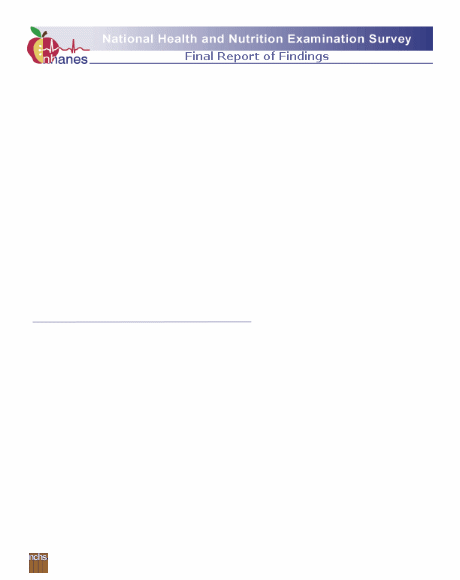
These measurements were obtained as part of a survey and do not represent a medical diagnosis.
Interpretation of these measurements must be made by a physician.

Date of Examination: DATE
Participant Name: Participant
Participant Age at Interview: xx years
Participant Age at Exam: xx years
Participant Gender: Female
SP ID: 123456
Body Measurements
Height: 5 ft. 4 in.
Weight: 122.9 lbs.
Blood Pressure & Heart Rate
ADULT (ages 18 years and up) |
Normal |
|
Systolic Blood Pressure: |
118 mm Hg |
< 120 |
Diastolic Blood Pressure: |
76 mm Hg |
< 80 |
Resting Pulse Rate: |
88 |
|
Cuff Size: |
Adult |
|
Your blood pressure today is within the normal range based on the American Cardiology Association (ACC) and the American Heart Association (AHA) Hypertension Guidelines for Prevention, Detection, Evaluation, and Management of High Blood Pressure in Adults. American Journal of Hypertension, 2018; 31 (2):133-135.
CHILD (ages 8-17 years)
-
Systolic Blood Pressure:
105 mm Hg
Diastolic Blood Pressure:
65 mm Hg
Resting Pulse Rate:
94
Cuff Size:
Child
Your child’s blood pressure today is within the normal range based on the American Academy of Pediatrics (AAP) Clinical Practice Guideline for Screening and Management of High Blood Pressure in Children and Adolescents. Pediatrics 2017; 140 (3):e20171904
SP ID, xx years, Female, 123456, Date Page 1
Centers for Disease Control and Prevention, NCHS 3311 Toledo Road, MS P08, Hyattsville, Maryland 20782
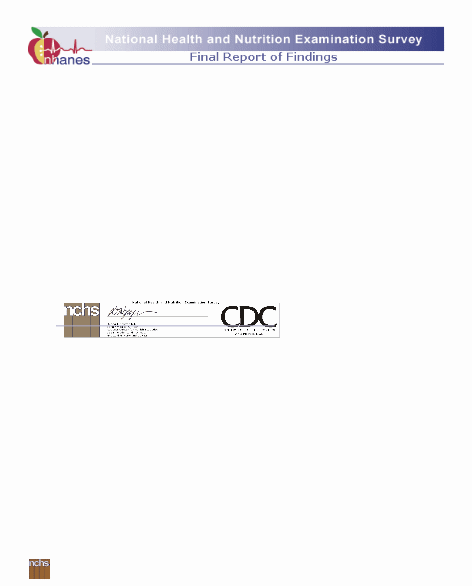
Complete Blood Count
-
White Blood Count
Result
7.0
Units
x109 /L
Flag
Reference Range
4.1 - 12.9
Lymphocytes
21.8
%
14.1 - 47.6
Monocytes
4.7
%
3.8 - 11.6
Neutrophils
56.6
%
39.8 - 78.1
Eosinophils
0.6
%
0.6 - 7.3
Basophils
1.4
%
0.1 - 1.7
Red Blood Count
4.7
x1012 /L
3.6 - 5.2
NRBC
0.0
x1012 /L
0.0 - 0.3
Hemoglobin
12.7
g/dL
10.6 - 15.6
Hematocrit
38.0
%
32.0 - 45.9
MCV
80.8
fL
74.6 - 98.2
MCH
26.0
pg
24.3 - 33.8
MCHC
33.4
g/dL
32.1 - 35.3
RDW
14.5
%
11.4 - 16.3
Platelet Count
360
x109 /L
168 - 441
--- Test not done
A/A/A/ Results still pending
<<< Lower than the limit of detection
>>> Above the limit of detection
vvv Delayed results Number of hours fasted prior to blood draw: 22
SP ID, xx years, Female, 123456, Date Page 2 Centers for Disease Control and Prevention, NCHS 3311 Toledo Road, MS P08, Hyattsville, Maryland 20782
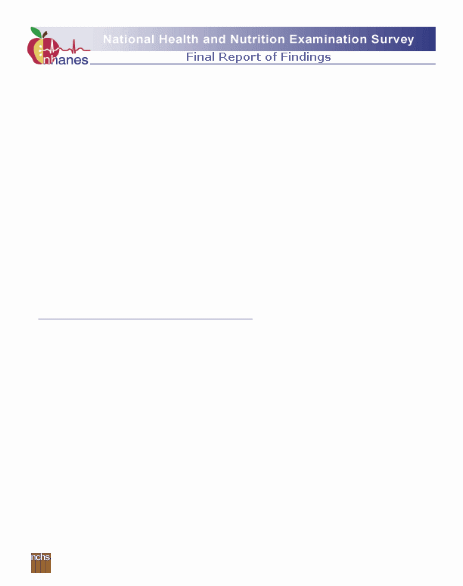 Blood
Tests
Blood
Tests
|
Result |
Units |
Flag |
Reference Range |
Glucose |
85 |
mg/dL |
|
60 - 109 |
Hemoglobin A1c |
4.6 |
% |
|
< 6.5 |
ALT |
10 |
IU/L |
|
< 31 |
AST |
11 |
IU/L |
|
< 31 |
Alkaline Phosphatase |
60 |
IU/L |
|
39 - 117 |
Albumin |
3.3 |
g/dL |
|
3.2 - 5.2 |
Bicarbonate |
20 |
mmol/L |
Low |
22 - 29 |
BUN |
7 |
mg/dL |
|
6 - 19 |
Calcium |
10.0 |
mg/dL |
|
8.4 - 10.2 |
Cholesterol |
182 |
mg/dL |
|
< 200 |
CPK |
30 |
IU/L |
|
22 - 199 |
Triglycerides |
87 |
mg/dL |
|
< 150 |
HDL |
66 |
mg/dL |
|
> 39 |
Phosphorus |
4.1 |
mg/dL |
|
2.6 - 4.5 |
Sodium |
136 |
mmol/L |
|
133 - 145 |
Potassium |
4.00 |
mmol/L |
|
3.30 - 5.10 |
Chloride |
102 |
mmol/L |
|
96 - 108 |
Total Protein |
6.9 |
g/dL |
|
5.9 - 8.4 |
Uric Acid |
3.7 |
mg/dL |
|
2.4 - 5.7 |
Bilirubin |
0.2 |
mg/dL |
|
0.0 - 1.0 |
Serum Folate |
48.8 |
nmol/L |
|
10.5 - 90.7 |
RBC Folate |
1610 |
nmol/L |
|
640 - 2006 |
Serum Ferritin |
48 |
µg/L |
|
15 - 150 |
Iron |
63 |
µg/dL |
|
22 - 163 |
Total Iron Binding Capacity (TIBC) |
344 |
µg/dL |
|
250 - 450 |
Transferrin Saturation |
18 |
% |
Low |
20 - 50 |
Lead |
0.5 |
µg/dL |
|
0.0 - 10.0 |
Vitamin D |
vvv |
µg/dL |
|
|
Cadmium |
0.1 |
µg/L |
|
0.3 - 1.2 |
Total Blood Mercury |
0.6 |
µg/L |
|
< 5.7 |
Testosterone |
500 |
μg/dL |
|
250-1100 |
Thyroglobulin ng/mL 1.5-29.2
|
5 |
ng/ml |
|
1.5-29.2 |
TSH |
4 |
mIU/dL |
|
0.45-4.12 |
Follicle Stimulating Hormone |
12 |
mIU/mL |
|
Varies individually |
Lutenizing Hormone |
15 |
mIU/mL |
|
Varies individually |
|
|
|
|
|
--- Test not done
A/A/A/ Results Still Pending
<<< Lower than the limit of detection
>>> Above the limit of detection
vvv Delayed Results Number of hours fasted prior to blood draw: 22
SP ID, xx years, Female, 123456, Date Page 3
Centers for Disease Control and Prevention, NCHS 3311 Toledo Road, MS P08, Hyattsville, Maryland 20782

Urine Tests
|
Result |
Units |
Flag |
Reference Range |
Albumin Creatinine Ratio - 1st Collection |
7.17 |
mg/g |
|
< 30.00 |
Total Arsenic |
--- |
µg/L |
|
|
Urinary Nickel |
--- |
µg/L |
|
|
Kidney Health
Your kidneys filter your blood and help control blood pressure. We checked how healthy your kidneys are by calculating your estimated glomerular filtration rate (eGFR). This is not a meaningful test if you are very muscular.
Your estimated glomerular filtration rate (eGFR) was 120 mL/min/1.73m2
This indicates normal function
This value is not meaningful for pregnant women, individuals with acute kidney failure, people with extreme body size or muscle mass (such as individuals who are bodybuilders, extremely obese or severely malnourished), and people on vegetarian or low-meat diets or taking creatine dietary supplements.
--- Test not done
A/A/A/ Results Still Pending
<<< Lower than the limit of detection
>>> Above the limit of detection vvv Delayed Results
SP, xx years, Female, 123456, Date Page 4
Centers for Disease Control and Prevention, NCHS 3311 Toledo Road, MS P08, Hyattsville, Maryland 20782

Body Composition
The whole-body scan provides information on your percent body fat.
The body composition exam results showed that your total body fat is ___%.
We do not know exactly what percent body fat is considered healthy for your age and gender.
Researchers are working to define the healthy ranges for the public. You may want to discuss this result
and your body measurement findings (page 1) with your doctor to find out what they mean for you. Too
much body fat can increase a person's risk of getting diabetes or heart disease.
Liver Elastography
Liver elastography measures the stiffness of your liver. In general, having liver stiffness may indicate liver damage.
Information from your liver ultrasound exam showed a value of 3.60 kiloPascals (kPa).
A scoring system (1), was used to interpret your result. Using this recommended scoring system, the result showed you have little or no liver stiffness. No additional follow-up regarding this test is recommended at
this time.
Published in GASTROENTEROLOGY 2005;128:343–350.
Balance
You performed a Modified Romberg test for balance during your examination. This screening test is listed by the Centers for Medicare and Medicaid (CMS) Physician Quality Reporting System for fall risk assessment.
SP, xx years, Female, 123456, Date Page 5 Centers for Disease Control and Prevention, NCHS 3311 Toledo Road, MS P08, Hyattsville, Maryland 20782
Laboratory Information
The following CLIA-certified laboratories performed the named tests on biologic specimens
NHANES Mobile Examination Center Laboratory National Center for Health Statistics 3311 Toledo Road, MS P08 Hyattsville, Maryland 20782 |
Complete blood count |
Diabetes Diagnostic Laboratory University of Missouri - Columbia 1 Hospital Drive Room M765 Columbia, MO 65212 |
Glucose and hemoglobin A1c |
Centers for Disease Control and Prevention National Center for Environmental Health Nutritional Biomarkers Branch Laboratory 4770 Buford Highway, NE MS F-55 Atlanta, GA 30341 |
Serum ferritin, serum folate, RBC folate, vitamin A(retinol), vitamin C and vitamin D |
Centers for Disease Control and Prevention NCEH / DLS / IRAT 4770 Buford Hwy. Building 103, Labs 1117, 1119, 1103 Mailstop F-18 Atlanta, GA 30341-3724 |
Total urinary arsenic, blood lead, cadmium, manganese, total blood mercury, selenium, inorganic blood mercury and urinary nickel |
Microalbumin Laboratory University of Minnesota 515 Delaware Street SE Room 13-219 - MOOS Tower Minneapolis, MN 55455 |
Urine albumin/creatinine ratio |
University of Minnesota Advanced Research and Diagnostic Laboratory 1200 Washington Ave S Suite 175 Minneapolis, MN 55415 |
Glucose, CPK, estimated glomerular filtration rate, iron binding, transferrin saturation, iron, ALT, AST, alkaline phosphatase, albumin, bicarbonate, BUN, calcium, cholesterol, triglycerides, HDL, LDL, serum creatinine, GGT, LDH, phosphorus, sodium, potassium, chloride, total protein, uric acid and bilirubin |
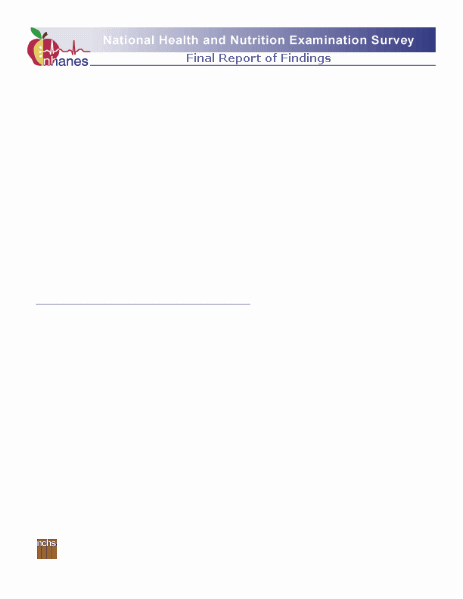
SP, xx years, Female, 123456, Date Page 6
Centers for Disease Control and Prevention, NCHS 3311 Toledo Road, MS P08, Hyattsville, Maryland 20782
1 As evidenced by the presence of CMV IgM and IgG antibodies.
| File Type | application/vnd.openxmlformats-officedocument.wordprocessingml.document |
| Author | Chiappa, Michele (CDC/DDPHSS/NCHS/DHNES) (CTR) |
| File Modified | 0000-00-00 |
| File Created | 2022-01-13 |
© 2026 OMB.report | Privacy Policy